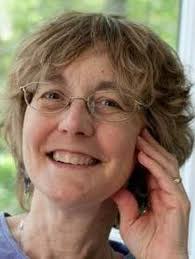Leia Marie: Lumpy Crossings
I am delighted when two themes appear in my life, mingle together and become one. Like the confluence of two great rivers, each magnificent in its own right, they join forces to carry me toward the sea. Such a river voyage came to me recently.
The first waterway emerged from a Krista Tippett interview with Irish theologian, poet, and conflict mediator Pádraig ÓTuama, who spoke eloquently of the difficulty of living well within our messy human world, where conflicts abound and peace seems often a distant dream.
As important as any of the words spoken, though, was the site at which the interview took place, for Corrymeela Community is one of Northern Ireland's organizations that was, and continues to be, instrumental in healing the divisions that fueled 30 years of internal war.
So even though the interview centered on the challenge of working creatively with divides that seem unbridgeable, its very location was proof that peace is possible among us. If it could be done in Ireland, it can be done here as well.
Enter the second river. A dear soul recently sent me the article Reasonable Hope by Kaethe Weingarten. Though it specifically focused on conveying a sense of possibility within a family therapy context, its applications to living in the world at large were clearly evident.
Weingarten notes that the "classic images of hope — a butterfly, a rainbow, an undemanding bird that perches in one’s soul — set up expectations and standards that are without limit," making them patently unattainable in most real-life situations.
She argues instead for "a humble hope", one that "softens the polarity between hope and despair, hope and hopelessness." She then goes on to articulate the dimensions of a reasonable hope, one that "accommodates doubt, contradictions and despair."
We then are in a position to employ our resources toward desired goals and identifying pathways to reach them. In this way, hope is transformed from something we have to something we do. Hope not as a noun, but a verb.
And those two rivers lift me up and carry me into real-world applications. Children dying in classrooms. War in Eastern Europe. Polarization and incivility within our own country. And those life-giving waters support me as they bring me toward the sea.
Ó Tuama speaks of the importance — and the difficulty — of coming home to "here", to the truth of what is, especially when it is disturbing. He notes that, "the notion of saying hello to "here" requires a fairly robust capacity to tell the truth about what is really going on."
Noting that "most people do what seems reasonable to them at the time," he encourages us not to vilify or "give insult back", reminding us that we, too, may need others "to extend their generosity" when we are acting poorly or in a way that seems incomprehensible to them.
As he speaks of these things that are so much easier to accept in theory than enact in practice, I remember that his words come out of an intimate acquaintance with the effects of war. He knows whereof he speaks.
From Weingarten I learn what it looks like to give reasonable hope its feet. I can admit that at times I despair that we will ever learn, while also accepting that the future is influenceable and, therefore, alive with possibility.
I practice in my own life and on a daily basis, choosing perspectives, words and actions that aim toward the change I'd like to see in the world. And I share this kind of hope, a reasonable kind of hope, in relationship with others. Such as you, dear reader.
The merging of these waterways is reflected in the name Corrymeela itself. When it was founded in 1965, someone with a passing knowledge of Old Irish linguistics said the name meant "hill of harmony", which they all found delightfully sweet at the time.
Ten years later, though, someone who knew more about Old Irish etymology said its meaning was closer to 'place of lumpy crossings,” which came as a relief because by then they'd realized that, "apart from the occasional song," they weren't so good at the harmony thing.
The people of Ireland were able to meet at the place of lumpy crossings to forge The Good Friday Agreement in 1998 that brought an end to the war, and have continued to meet at that place ever since to address the lingering effects of decades of sectarian violence.
As I said, if they can do it there, we can do it here. While we might wish to live always on the hill of harmony, the "here" of humankind seems more a place of lumpy crossings. To not acknowledge that is to set ourselves up for failure.
This lumpiness is the "here" Ó Tuama describes as "a complicated compromise" where we get to "participate in this fantastic argument of being alive." And it is the "here" that can give rise, if we let it, to a reasonable hope. Again, if they did it there, we can do it here.
And as these watercourses carry me to the sea, I end with a quote from the epilogue of This Tender Land, a novel by William Kent Krueger.
"There is a river that runs through time and the universe, vast and inexplicable, a flow of spirit that is at the heart of all existence, and every molecule of our being is a part of it." Another very important and balancing "here" for us all, whether we agree on everything or nothing.
If we can remember that every single one of us is part of that flow, maybe it will be easier to greet each other with respect, sincere interest, and heartful compassion, here in this place of lumpy crossings.

Leia Marie is a psychotherapist, spiritual mentor and reiki practitioner. She can be reached at silvermountain@mac.com.
This article originally appeared on The Pueblo Chieftain: Leia Marie: Lumpy Crossings
